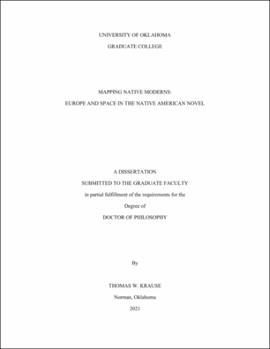| dc.description.abstract | This dissertation, “Mapping Native Moderns,” analyzes Native American literature for its settings in England, France, and Italy. Examples include an unpublished manuscript written in the late 1920s by D’Arcy McNickle (Confederated Salish and Kootenai), as well as late twentieth- and early twenty-first-century novels by Leslie Marmon Silko (Laguna Pueblo), James Welch (Gros Ventre/Blackfeet), and Gerald Vizenor (Anishinaabe). I argue that the latter three writers turned to historical fiction to envision complex, counterhegemonic depictions of American Indians in Europe set in the modernist era and during the Columbian Quincentenary. From the late 1880s to the early 1920s, often referred to as the assimilation and/or allotment era, U.S. federal Indian policies stressed forced cultural assimilation, fee simple land ownership, and Americanization as the means of survival for Native Americans at the onset of modernity. Like the myth of the “vanishing Indian” that attended them, these policies and their destructive effects have influenced writing by and about Indians, from the nineteenth century to 1992 and into the present day. As a result, Native absence is more common than Native presence in modernist and contemporary fiction, and rarer still in settings outside the United States. Drawing on scholarship by Gaston Bachelard, Amy Kaplan, Bertrand Westphal, Scott Richard Lyons (Ojibwe/Dakota), Mishuana Goeman (Tonawanda Band of Seneca), Vizenor, and others, I explore how McNickle, Silko, Vizenor, and Welch have written American Indian characters into European literary geographies and histories from which Indians have been wrongfully separated. How the novelists studied in this dissertation arrange, compare, contrast, and interpret space in America and Europe, from the American Southwest to Corsica, is a forceful rebuke to the cartographic, historical, and literary making of Euro-American spaces and the erasure and removal of Indians from them. | en_US |
